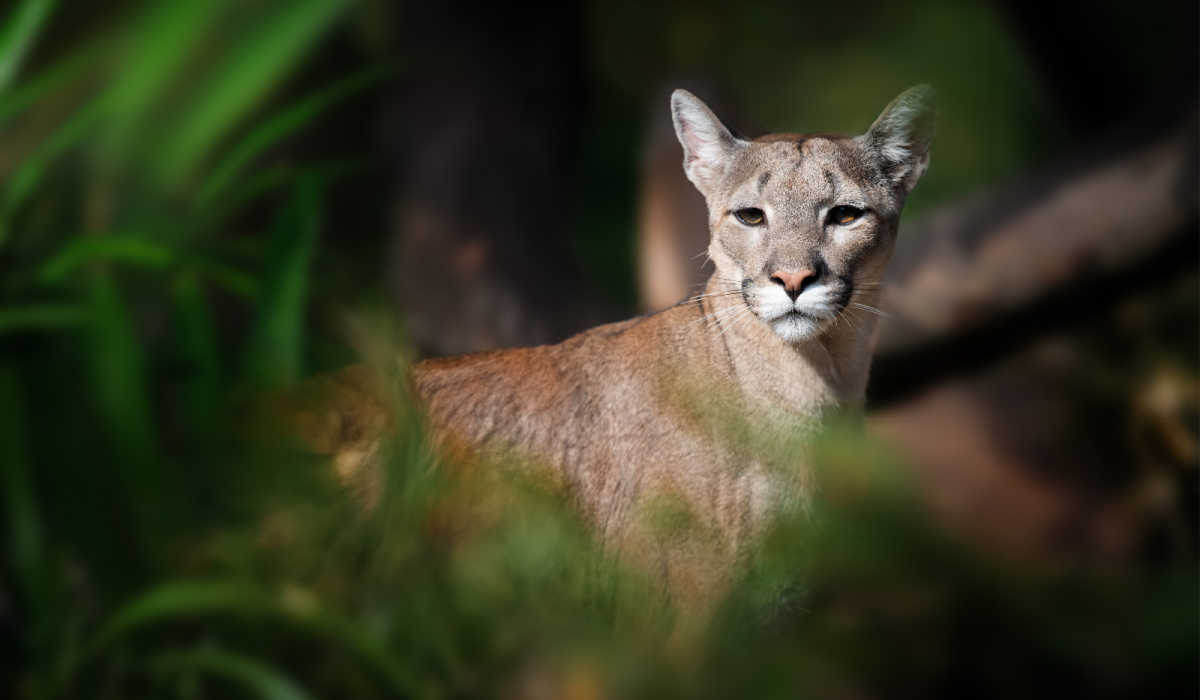Mountain lions, also known as cougars or pumas, were once native to Arkansas. However, these large cats were believed to have disappeared from the state around the 1920s. In recent years, there have been numerous reported sightings of mountain lions in Arkansas, sparking public interest and raising questions about the presence of these elusive animals in the region.
While no local population of mountain lions is currently believed to exist in Arkansas, state wildlife officials continue to receive regular reports of potential sightings. These officials follow up on any photographic or physical evidence available to determine if the animal in question is a mountain lion. Confirmed sightings have occurred, indicating that mountain lions are indeed present within the state, albeit not as part of a local breeding population.
These sightings seem to be growing in frequency but, as of now, are only up to 1-2 sightings per year (confirmed). From 2010 to 2018 there were only 14 sightings confirmed by the AGFC.
Due to the transient nature of these mountain lions, it is possible that the animals spotted have ventured into Arkansas from other neighboring states with established populations. This suggests that the distribution of these elusive predators is continuously shifting, making their presence in Arkansas a subject of ongoing interest and research.
Existence of Mountain Lions in Arkansas
Historical Population
Mountain lions, also known as cougars, were once native to Arkansas. However, they were considered extirpated (locally extinct) in the eastern United States for almost 100 years. Despite this, roaming mountain lions from western states occasionally travel east in search of territory.
Current Sightings
There have been numerous reports of mountain lion sightings in recent years. People often claim to have seen mountain lions or captured images of them on private land or game cameras. Notable sightings have occurred in areas such as Fulton County and Bradley County. Although many of these sightings have been reported, not all have been confirmed or supported with physical evidence.
Confirmed Cases
The Arkansas Game and Fish Commission (AGFC) has been contacted on hundreds of mountain lion sightings, but only 15 have been confirmed by the organization so far. Myron Means (Large Carnivor Program Coordinator at AGFC) mentions that the presence of mountain lions might be linked to their mating season when they travel more extensively in search of a mate.
While there doesn’t seem to be a stable, reproducing wild population currently residing in Arkansas, extensive forests in the state provide suitable habitats for possible reintroduction of mountain lions in the future.
Predator Dynamics in Arkansas
Interactions with Other Predators
In Arkansas, mountain lions exist alongside other predators, such as bobcats, wolves, coyotes, and raccoons. Historically, there have been instances of predator control measures, like bounties and trapping, that targeted predator populations in the state. For instance, during 1927-29, at least 255 wolves and 523 bobcats were killed. However, no mountain lions were taken during this period.
Prey Predilections
The diet of Arkansas mountain lions is heavily influenced by the availability of prey. Deer remain their primary prey. As the deer population grows in the state, so does the mountain lion population. Mountain lions also hunt smaller mammals and birds, such as wild turkeys, to supplement their diet.
Impact on Deer Population
Arkansas experienced a resurgence in its deer population in the 1930s and 1940s, thanks to the establishment of state and federal game refuges, a deer restocking program, improved deer habitat, and strictly enforced hunting regulations. Today, the deer population in Arkansas exceeds 60,000 animals. The mountain lion population has also seen an increase, responding to the abundance of their primary prey. Consequently, mountain lions may have an impact on the deer population, but they have also adapted to the increased predation pressure by maintaining a well-balanced predator-prey dynamic.
Mountain Lions Across the United States
Populations in Other States
Mountain lions, also known as cougars or pumas, are distributed across various parts of the United States. Most of their population is found on the West Coast, including states like Colorado, Utah, Wyoming, Arizona, California, Idaho, Montana, Nevada, New Mexico, Oregon, Texas, and Washington.
However, a few eastern states have reported the presence of mountain lions as well. The Florida panther, a subspecies of mountain lion, is found only in Florida, particularly in the Everglades. The panthers in Missouri, a state that is predominantly known for black bears, are believed to be roaming cougars from western states. Additionally, there is evidence supporting the return of mountain lions in some eastern states like New York and North Carolina.
Habitat Preferences
Mountain lions are highly adaptable creatures that can make their home in different terrains. They are observed in a range of habitats that include mountains, deserts, forests, and swamps. Here are brief examples of mountain lion habitats in specific states:
- Florida: In the Everglades, the Florida panthers reside in swamps and wetlands.
- Utah: Mountain lions are typically found in the wilderness, with populations concentrated in the Cascade Mountains.
- Northern Arkansas: In Mammoth Spring, mountain lions inhabit wooded areas and remote regions.
This widespread distribution indicates the ability of these animals to thrive in diverse environments. The comeback of mountain lion populations across the United States shows their resilience and adaptability in finding suitable habitats for survival.
Conservation and Management
Hunting and Legal Status
Mountain lions are currently not considered a game animal in Arkansas, and they are protected by law. Hunting of these cougars is not allowed, and any incident of killing a mountain lion must be immediately reported to the Arkansas Game and Fish Commission (AGFC) for investigation. In the past, bounties existed for hunting mountain lions, but they have since been discontinued to protect the remaining population.
Reintroduction and Conservation Efforts
Conservation efforts in Arkansas have focused on understanding the current status and presence of mountain lions in the state. In recent years, there have been confirmed sightings of mountain lions near Mammoth Spring in northern Arkansas, as reported by the AGFC. Biologists have utilized game cameras and DNA analysis to verify the presence of these solitary, elusive animals.
The AGFC, in collaboration with the U.S. Fish and Wildlife Service and the U.S. Forest Service, continues to monitor and study mountain lions in Arkansas. Their conservation efforts aim to understand their population status, habitat requirements, and the possible need for reintroduction measures to ensure the survival of these predators in the state.
Education and Public Awareness
Educating the public on the presence, behavior, and importance of mountain lions in Arkansas is crucial to their conservation. The AGFC and other conservation organizations promote awareness about these apex predators and their role in the ecosystem. By informing the public about mountain lions’ solitary nature and the need for large areas of habitat, these efforts aim to foster understanding, coexistence, and support for conservation initiatives in Arkansas.
How To Know If You’ve Seen A Mountain Lion In Arkansas
Physical Characteristics
The mountain lion (Puma concolor) is a large and elusive big cat native to North America. Its coat varies in color from light tan to brownish-gray, with a white underside. Mountain lions measure around 5-9 feet in length, including a long, thick tail that can be up to one-third of their body length. Males weigh between 130-160 pounds, while females typically weigh between 65-105 pounds.
Behavioral Traits
Mountain lions are highly adaptable creatures and can be found in various habitats, including forests, grasslands, and swamps. They are solitary animals, predominantly active during the night and at dawn or dusk. Although they are elusive and rarely seen by humans, mountain lions are sometimes detected using game cameras or when images are shared on social media platforms such as Facebook.
Distinction from Other Big Cats
It is crucial to distinguish mountain lions from other big cats like black panthers and jaguars. Black panthers, although not a separate species, are melanistic leopards or jaguars with an all-black coat. Key differences between mountain lions and black panthers include the panther’s lack of a long tail and the presence of distinct rosette patterns visible on their black fur.
Jaguars, on the other hand, are a separate species altogether and can be identified by their larger size, broader head, and more extensive rosette patterns compared to mountain lions.
In general, mountain lions can be identified by their specific physical characteristics and the absence of defining features found in other big cats.
Notable Reports and Stories
In recent years, there have been several reports and stories about mountain lion sightings in Arkansas. One notable incident occurred in 2018 when the Arkansas Game and Fish Commission confirmed the sighting of a mountain lion near Mammoth Spring in northern Arkansas. A game camera photo of the mountain lion was taken in January and sent to the AGFC, where biologists were able to verify the photo and its location.
Despite various reports and photographs taken by game cameras with infrared motion detectors, the commission’s biologists maintain that any free-ranging mountain lions in Arkansas are possibly escaped or released pets from irresponsible owners. Wildlife officials have confirmed only 15 sightings in the state since 2010. The 14th sighting of a mountain lion was reported around 2018, showing that these encounters, while still rare, are becoming more frequent.
Deer hunters and trappers have also contributed to the accounts of mountain lion sightings in Arkansas, raising questions about the possible migration or repopulation of these elusive creatures in the region. Along with Oklahoma and Louisiana, Arkansas seems to be part of a larger regional trend where mountain lions are slowly returning or expanding their territories.
To summarize, while the existence of mountain lions in Arkansas remains a topic of debate and speculation, notable reports and stories from various sources – including hunters, trappers, and game cameras – have provided some intriguing evidence. As wildlife officials continue to monitor the situation, we can expect further developments on this fascinating subject.







